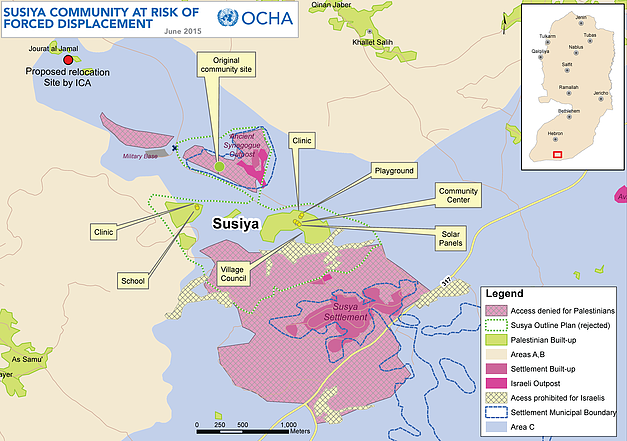Susiya: a community at imminent risk of forced displacement | June 2015
Key facts
- Susiya, a Palestinian community located in the Hebron governorate in the south of the occupied West Bank, is currently home to 55 nuclear families, who have been living in this location for decades, on land they claim as their private property.
- The homes of half of these families (28) and all the community’s public structures are located in Area C, where Israel maintains full control over planning and zoning, and the remainder in Area B.
- In 1986, the Israeli authorities declared the main residential area of Susiya an archaeological site and evicted all of its residents. Most of those who relocated to what was later designated as Area C were displaced again in the context of two waves of demolitions, in 2001 and in 2011, on grounds of lack of building permits.
- All the 170 structures located in Area C have outstanding demolition orders, which include 32 residential tents and shacks, 26 animal shelters plus 66 family utility structures, 20 cisterns and 20 latrine units, two clinics, a school and a kindergarten, among others; approximately half of these structures have been funded by international donors and provided as humanitarian assistance.
- The nearby Israeli settlement of Susya, established in 1983 in contravention to international law, has a population of nearly 1,000, some of whom live in an unauthorized outpost erected in 2002 in the old community centre that was declared an archeological site.
- By the end of the 1990’s the Israeli authorities have allocated over 1,500 dunums of land to the development of Susya settlement (the “municipal boundaries”), an area that is over five times larger than its current built-up area.
- Due to systematic settler violence and intimidation, Susiya residents have limited or no access to over 2,000 dunums of land, which constitute about two-thirds of the community’s farming and grazing area.
- In 2014 alone, some 800 olive trees and saplings owned by Palestinian residents of Susiya were vandalized and damaged, allegedly by Israeli settlers.
- Susiya residents spend up to a third of their income on tankered water: 25 NIS per cubic meter, or five times more than the nearby settlers, who are served by the water network.
- Susiya residents in Area C are at imminent risk of forced displacement. All structures located in Area C have been served with demolition orders, which can be implemented at any moment. In addition, the Israeli authorities have recently expressed their intention to “relocate” this community to a nearby site. Combined with the longstanding access restrictions to basic services and grazing land, and systematic intimidation by Israeli settlers, this creates a coercive environment, which raises concerns about forcible transfer.
- Residents have been denied adequate planning and face discrimination. Planning schemes submitted by the residents to the Israeli authorities, which would allow the issuance of building permits on land that they own, have been repeatedly rejected. Although a petition against this rejection filed with the Israeli High Court of Justice (HCJ) is currently pending, the HCJ refused to issue an interim injunction freezing demolitions until a ruling on the case. By contrast, the nearby Susya settlement has been granted a generous outline plan that allows for the development of housing and infrastructure. While the adjacent settlement outpost was established without permits, the authorities have connected it to the water and electricity networks and refrained from enforcing pending demolition orders.
- The living conditions of Susiya families are extremely precarious. Following the demolition of their homes in previous years and the inability to obtain building permits, most families reside in temporary shelters (tents and shacks), which provide little protection from the weather conditions. The Israeli authorities have refused to connect the community to the water network or install a filling point, as a result of which, residents rely on rainwater collection and purchase of expensive tankered water. Likewise, the community is not connected to the electricity network and depends on solar panels for lighting and heating.
- People’s access to their farming and grazing land has been progressively reduced due to systematic abuse and intimidation by Israeli settlers, undermining their livelihoods and security. Incidents recorded in recent years include physical assault, verbal harassment, vandalizing of property, access denial, and takeover of land. This situation is compounded by the Israeli authorities’ inadequate law enforcement against violent settlers. A petition to the HCJ filed by the residents in 2010, requesting the authorities to secure them access to their land and to evacuate Israeli settlers from areas they have taken over and began cultivating, was rejected. However, the authorities have secured the farmers’ access to a few plots (a small portion of the land in question) by prohibiting the entry of Israeli settlers to these plots.
- Israel, as the occupying power in the West Bank, has a legal obligation to protect the Palestinian civilian population and to administer the territory for their benefit. International law prohibits the forced transfer or displacement of civilians and the destruction of private property. It also prohibits forcible transfer of the population of the occupying power into occupied territory, as reflected in the establishment of settlements.










